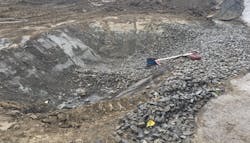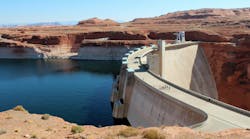Eric A. Dubcak, CESCL is a group manager at Terracon’s Seattle office specializing in environmental and storm water project work for a wide variety of clients throughout the Pacific Northwest. Dubcak can be reached at [email protected].
undefinedThe groundbreaking ceremony is close. Demolition and construction plans are complete, submitted and corrections and revisions have been addressed. Respective agencies have provided approximate issuance dates, and you are ready for the pre-construction and project kick off. Everything is going as planned. Then this all too common response is heard: “Wait, what do you mean? I’m sure storm water is covered! I’ll make a few calls and get back to you.”
After reviewing contracts, sometimes it’s unclear who is the responsible party to cover storm water in accordance with the required National Pollution Discharge Elimination System (NPDES) permit to discharge storm water to surface waters of the state. What now? Who do we contact?
In some cases, the general contractor will exclude storm water from their scope of services or possibly include portions of these services. During the process of completing the required applications or Notice of Intent (NOI) to discharge, it can be identified that the site has a history of environmental issues (e.g., gas stations, dry cleaners, auto repair), which could trigger additional and costly requirements to allow the discharge of storm water. This could contribute to additional review time by the agencies. If additional treatment is required for storm water prior to discharge, additional expenses not included in the original project budget can be incurred. Property owners may be confused when an agency issues a no-further- action (NFA) for a cleanup that has occurred on the property, but this does not relieve the historic site from potential impacts to surface water standards.
Generally construction projects require a Storm Water Pollution Prevention Plan (SWPPP) or an erosion sediment plan to assist with the proper management of erosion and sediment due to the exposed soils from routine earthwork. While the SWPPP preparer can vary from the inspector and the agency(s) requiring notification and/or discharge monitoring reports (DMRs), the end goal is the same state-to-state – to use available technologies to decrease erosion potential and prevent sediment from leaving the site via storm water discharge. Many times, a standard boilerplate SWPPP can direct an experienced storm water inspector to maintain compliance for the project duration. However, it’s those times when the all too common best management practices (BMPs) are selected for a site, and they are not effective and/or simply do not work. For example, a sediment pond used for storage and/or infiltration may be presented on the temporary erosion sediment control (TESC) plan to satisfy the ‘check the box’ on the plan review. This TESC is then used to prepare the text of the SWPPP. Unless a person with storm water experience reviews the plan and provides feedback, generic TESC plans are sometimes only composed of catch basin inserts, perimeter silt fence, some type of water conveyance, a construction entrance and either baker tanks and/or a sediment pond.
While this is a common method that often works well, in some cases, the site does not infiltrate, or the silts do not settle, no matter how long the ponded water is left undisturbed. This undesirable outcome is unexpected and can result in costly efforts to manage the storm water for qualified discharge.
Construction Case Studies
A project in the Pacific Northwest placed a development of a site with a steep hillside (i.e., increased flow velocities for erosion and sediment transfer) and a mix of soils with silt, clays and loose organic soils. The TESC called for a sediment pond, which was installed. Storm water that directly accumulated in this pond was clear. However, water pumped to the sediment pond from other areas of the site was extremely turbid, and the combined water in the pond remained turbid. Settling was not an option. Working in the wet season resulted in constant rainfall and accumulation of the turbid storm water. Unplanned tanks had to be delivered to the site to allow for increased storage capacity in hopes the water would settle. After running out of tank capacity and the water being outside discharge parameters, a water treatment subcontractor was required to set up a filtration system for all storm water leaving the site. This treatment system not only managed the turbidity using chemical treatment methods, it also adjusted the pH within permit parameters. It is typical for sites where catch basin inserts (i.e., witch hats) surrounded by straw wattles look like an effective BMP on the TESC plan and the SWPPP. However, frequently this is not enough to maintain storm water in compliance within permit parameters. While these BMPs are helpful as an added layer of control, storm water accumulated within the disturbed soil area may be required to be pumped to a collection system (i.e. baker tanks, holding pond) and then passed through a chemical treatment system and sampled prior to discharge.
The need for additional treatment efforts is not as uncommon as one would expect. To avoid these situations, discussion should be focused on awareness for property owners and general contractors to raise such questions earlier in the planning stages. This approach will allow sufficient time to obtain permits, find subcontractors and include a budget to cover items, such as chemical treatment. Many times, this exact scenario doesn’t occur, and there are no additional efforts needed outside of what has been planned in the SWPPP.
Another case study detailed a small project site where the drainage permits were submitted, and the plan indicated construction storm water would discharge to the storm sewer in the right of way (ROW). While this could have worked, the permits to complete the utility work and tie into the storm sewer main in the ROW had not been issued in time and earthwork at the site had already begun, resulting in soils being exposed just in time for the wet season. Sometimes there are options to discharge to the sanitary sewer and pay for discharge by the gallon. This could require approval from the municipal or county treatment facility in addition to the approval by the local municipality to utilize sewer lines to handle increased volumes. While this may not be considered, the city manages the volumes and flow rates entering these lines, and they have authority to reject the discharge or place a daily discharge volume to the system, due to potential other projects in the area.
In this scenario, the drainage plan review was completed and the permit was issued to allow discharge to the storm sewer; therefore, the permit reviewer was unwilling to modify the plans to allow discharge into the sanitary sewer. The site was less than an acre and the state regulations did not require an NPDES permit to discharge to the storm sewer; however, at the time, the contractor was unable to make a connection to the storm sewer because of delay in obtaining a right-of-way permit. It was also discovered that the site had a history of environmental uses, which would likely trigger the requirement for a permit, sampling, and possible treatment prior to discharge. In this instance, that would have added up to a minimum of 60 days to be granted coverage to discharge to the storm sewer.
Since discharge to the sanitary sewer was not an option, proceeding with a storm sewer permit could take additional time before authorized to discharge. However, there was not a connection to the storm line and earthwork was already underway during the wet season. The more costly option would consist of collection, trucking and offsite disposal. Through daily observations of rainfall, it was determined that the site soils were favorable, and the storm water was infiltrating into the site. Additionally, a storage tank was brought to the site to allow collection of storm water in the case of a major rain event and the storm water could be trucked offsite, as needed. This provided time to proceed with earthwork activities to stabilize the site (i.e. cover exposed soil) and then allow time to make the connection to the city storm sewer. Once the site was stabilized, this reduced the potential for discharge of storm water that had contacted exposed soils and then storm water could be discharged as previously approved in the drainage plans.
Take Away
If storm water discharge authorization is not in place, the question to ask is “Is it time to consider a more detailed line of questions pertaining to storm water management?” If you are not sure what to ask or there is not a qualified team member on the project, seek outside support to perform a review of the site, history, and plans for managing storm water. Don’t be a victim of delayed schedules due to waiting for a permit to discharge or take a hit to the overall budget and bonuses due to unplanned subcontractor storm water treatment fees.






